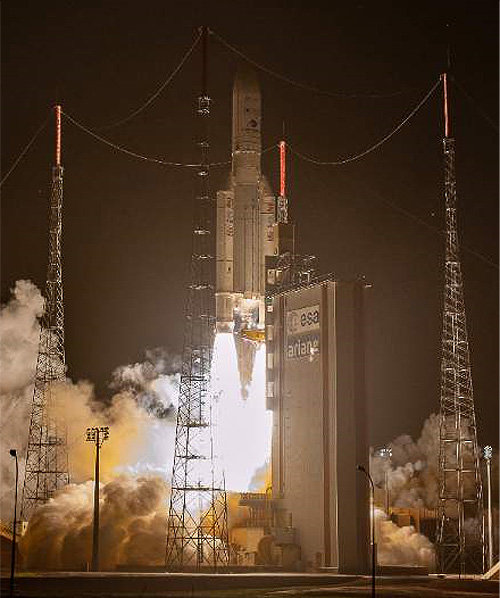S. Korean satellite to trace the movement of fine dust
S. Korean satellite to trace the movement of fine dust
Posted February. 20, 2020 08:16,
Updated February. 20, 2020 08:16

At 7:18 p.m. on Tuesday, the control center of the Guiana Space Centre located in French Guiana, South America was filled with tension as the “Cheollian 2B,” a South Korean-built satellite that is designed to monitor the environment and oceans, was still on the “Ariane 5” rocket. When the satellite successfully separated from the rocket 31 minutes after the liftoff at 7:49 p.m. and communicated it to a tracking station in Australia at 7:55 p.m., a happy scream burst out of the room.
The Cheollian 2B is the world’s first geostationary satellite that will monitor the atmosphere around the Korean Peninsula in real time from about 36,000 kilometers above for the next 10 years. The environmental sensors on the satellite measure levels of nitrogen dioxide, sulfur dioxide and ozone in the air that can contribute to particulate matter formation or climate change, enabling the tracing of the movement of fine dust in Northeast Asia. “Unlike existing satellites that monitor the environment once or twice a day, the Cheollian 2B collects information for 12 hours a day during the day, providing a more accurate and detailed picture of the movement of particulate matters,” said Jang Yun-seok, the head of the National Institute of Environmental Research (NIER).
The new satellite also allows the monitoring of the oceans. Ocean sensors mounted on it can not only to capture the development of red tide, brown algae and sargassum horneri but also monitor marine litter and its movement. It can detect signs of sea fog and the thaw and help the fish industry by monitoring fisheries. “The satellite can contribute to research on patterns in marine environments such as El Niño or La Niña that change ocean surface temperatures over a long period of time,” said Yoo Ju-hyeong, the head of the Ocean Satellite Center at the Korea Institute of Ocean Science and Technology (KIOST).
The Cheollian 2B is a result of the collaboration of multiple government departments, including the Ministry of Science, ICT and Future Planning, the Ministry of Environment and the Ministry of Oceans and Fisheries, starting from 2011. Led by the Korea Aerospace Research Institute, the mission also involved the Republic of Korea Institute of Ocean Science & Technology, Korea Aerospace Industries, Ball Aerospace & Technologies from the United States and Airbus from France.
ashilla@donga.com






![[단독]“男 군대가니 女도 가라는 식으로 여성징병제 문제 못풀어”](https://dimg.donga.com/c/138/175/90/1/wps/NEWS/IMAGE/2025/12/08/132907201.1.jpg)
